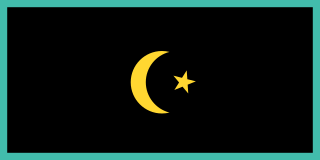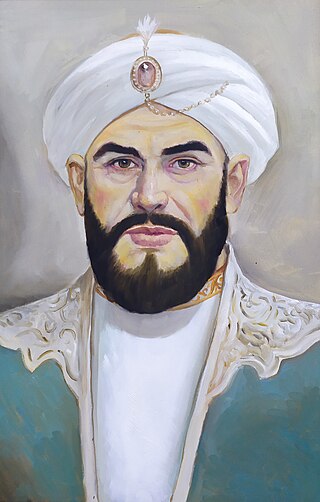Related Research Articles

Khwarazm or Chorasmia is a large oasis region on the Amu Darya river delta in western Central Asia, bordered on the north by the (former) Aral Sea, on the east by the Kyzylkum Desert, on the south by the Karakum Desert, and on the west by the Ustyurt Plateau. It was the center of the Iranian Khwarezmian civilization, and a series of kingdoms such as the Afrighid dynasty and the Anushtegin dynasty, whose capitals were Kath, Gurganj and—from the 16th century on—Khiva. Today Khwarazm belongs partly to Uzbekistan and partly to Turkmenistan.

Khiva is a district-level city of approximately 93,000 people in Khorazm Region, Uzbekistan. According to archaeological data, the city was established around 2,500 years ago. In 1997, Khiva celebrated its 2500th anniversary. It is the former capital of Khwarezmia, the Khanate of Khiva, and the Khorezm People's Soviet Republic. Itchan Kala in Khiva was the first site in Uzbekistan to be inscribed on the World Heritage List (1991). The astronomer, historian and polymath, Al-Biruni was born in either Khiva or the nearby city of Kath.

The Khorezm People's Soviet Republic was the state created as the successor to the Khanate of Khiva in February 1920, when the Khan abdicated in response to pressure. It was officially declared by the First Khorezm Kurultay (Assembly) on 26 April 1920. On 20 October 1923, it was transformed into the Khorezm Socialist Soviet Republic.

Itchan Kala is the walled inner town of the city of Khiva, Uzbekistan. Since 1990, it has been protected as a World Heritage Site.

The Khanate of Khiva was a Central Asian polity that existed in the historical region of Khwarazm from 1511 to 1920, except for a period of Afsharid occupation by Nader Shah between 1740 and 1746. Centred in the irrigated plains of the lower Amu Darya, south of the Aral Sea, with the capital in the city of Khiva. It covered present-day western Uzbekistan, southwestern Kazakhstan and much of Turkmenistan before the Russian conquest at the second half of the 19th century.

The Emirate of Bukhara was a Muslim-Uzbek polity in Central Asia that existed from 1785 to 1920 in what is now Uzbekistan, Tajikistan, Turkmenistan and Kazakhstan. It occupied the land between the Amu Darya and Syr Darya rivers, known formerly as Transoxiana. Its core territory was the fertile land along the lower Zarafshon river, and its urban centres were the ancient cities of Samarqand and the emirate's capital, Bukhara. It was contemporaneous with the Khanate of Khiva to the west, in Khwarazm, and the Khanate of Kokand to the east, in Fergana. In 1920, it ceased to exist with the establishment of the Bukharan People's Soviet Republic.

Reza-Qoli Khan Hedayat was an Iranian literary historian, administrator, and poet in 19th-century Qajar Iran.

The Kazakh Khanate, in eastern sources known as Ulus of the Kazakhs, Ulus of Jochi, Yurt of Urus, was a Kazakh state in Central Asia, successor of the Golden Horde existing from the 15th to the 19th century, centered on the eastern parts of the Desht-i Qipchaq.

Abu al-Ghazi Bahadur was Khan of Khiva from 1643 to 1663. He spent ten years in Persia before becoming khan, and was very well educated, writing two historical works in the Khiva dialect of the Chagatai language. He was a descendant of Genghis Khan via Arab Shah.
The Sufid dynasty was a Turkic dynasty of Mongolic origin that ruled in Khwarazm within the realm of the Golden Horde in the Amu Darya river delta. Although the dynasty's independence was short-lived, its later members continued to rule Khwarezm intermittently as governors of the Timurid Empire until the takeover of Khwarezm by the Shaybanid Uzbeks in 1505. Unlike earlier dynasties that ruled from Khwarezm, the Sufids never used the title Khwarazmshah.

The Yomut or Yomud is a Turkmen tribe that lives in Western and Central Asia, including Gorgan, Iran; Turkmenbashi, Turkmenistan; the eastern Caspian shores; Khiva, Uzbekistan; and Dashoguz, Turkmenistan.

Iranian Turkmens are a branch of Turkmen people living mainly in northern and northeastern regions of Iran. Their region is called Turkmen Sahra and includes substantial parts of Golestan Province of Iran. The number of Turkmens in Iran is estimated at 0.5 to 2.4 million people.

During the mid-eighteenth century the Afsharid empire of Nader Shah embarked upon the conquest and annexation of the Khanates of Bukhara and Khiva. The initial engagements were fought in the late 1730s by Nader Shah's son and viceroy Reza Qoli Mirza who gained a few notable victories in this theatre while Nader was still invading India to the south. Reza Qoli's invasions of Khiva angered Ilbars Khan, the leader of Khiva. When Ilbars threatened to make a counter-attack Nader ordered hostilities to cease despite his son's successes and later returned victoriously from Delhi to embark on a decisive campaign himself.

In the Russo-Khivan War of 1873, Russia conquered the Khanate of Khiva, and it became a Russian protectorate.

In the 16th century, the Tsardom of Russia embarked on a campaign to expand the Russian frontier to the east. This effort continued until the 19th century under the Russian Empire, when the Imperial Russian Army succeeded in conquering all of Central Asia. The majority of this land became known as Russian Turkestan—the name "Turkestan" was used to refer to the area due to the fact that it was and is inhabited by Turkic peoples, excluding the Tajiks, who are an Iranian ethnicity. Upon witnessing Russia's absorption of the various Central Asian realms, the British Empire sought to reinforce India, triggering the Great Game, which ended when both sides eventually designated Afghanistan as a neutral buffer zone.
The Russo-Khivan War of 1839–1840 was a failed Russian attempt to conquer the Khanate of Khiva. Vasily Perovsky set out from Orenburg with 5,000 men, met an unusually cold winter, lost most of his camels, and was forced to turn back after going halfway.
The Khivan Revolution refers to the events of 1917–1924, which led to the elimination of the Khanate of Khiva in 1920, the formation of the Khorezm People's Soviet Republic, the intervention of the Red Army, the mass armed resistance of the population and its suppression, the inclusion of the republic into the Soviet Union on 27 October 1924, as a separate union republic, the elimination of the newly established republic as a result of national delimitation and the formation of the Uzbek SSR, the Turkmen SSR in 1924.

Isfandiyar Khan, or Asfandiyar Khan, born Isfandiyar Jurji Bahadur, was the Khan of Khiva between September 1910 and 1 October 1918, the 53rd Khan of Khiva, and the 12th Khongirad ruler of the Uzbeks. He was overthrown and executed by Junaid Khan in 1918.
Sayyid Muhammad Rahim Bahadur II was Khan of Khiva from 1864 to 1910, succeeding his father Sayyid Muhammad Khan. Khiva was turned into a Russian protectorate during his rule, in 1873.

Junaid Khan ; (b.1857/62–1938) was a Turkmen tribal leader who became the Chief of the Armed Forces and later the de facto and last ruler of the Khanate of Khiva.
References
- ↑ History of the Mongols: From the 9th to the 19th Century, Volume 2, Issue 2 By Sir Henry Hoyle Howorth (family tree page 685)